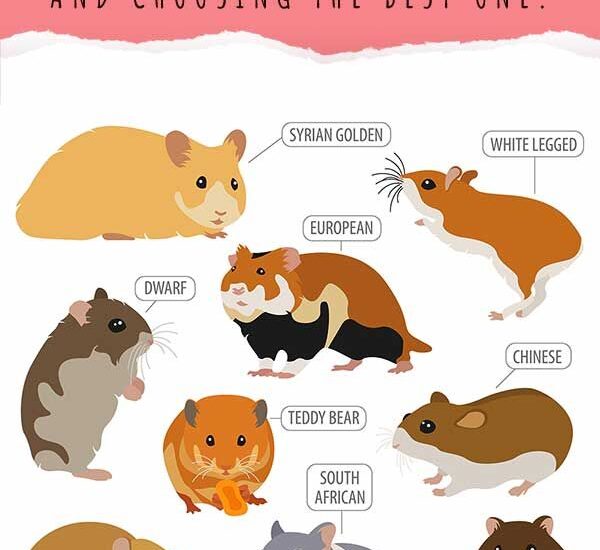Popular Hamster Species for Pets
Hamsters are delightful creatures that make excellent pets, known for their small size, playful behavior, and relatively low-maintenance care needs. With several species available, each with its unique characteristics, choosing the right hamster can enhance your experience as a pet owner. This article explores the most popular hamster species to help you make an informed decision when selecting your furry friend.
Common Hamster Breeds
When it comes to selecting a hamster breed, several varieties are most commonly kept as pets. Understanding their distinct traits, behavior, and care needs is crucial to ensure both you and your pet have a fulfilling companionship.
Syrian Hamster
The **Syrian hamster**, also known as the golden hamster, is perhaps the most recognizable pet hamster. This breed can reach up to 6 inches long and has a friendly demeanor, making it ideal for families. Typical colors include golden, black, and agouti, but many variations exist due to selective breeding. When cared for properly, Syrian hamsters can live for about 2 to 3 years. They thrive in spacious cages with plenty of enrichment, such as tunnels and wheels, to keep them active and entertained.
/GettyImages-1157798585-41025aa3b70f4615b234fd9fb30d7d1b.jpg)
Campbell’s Dwarf Hamster
The **Campbell’s dwarf hamster** is another popular option for pet owners. Smaller in size, averaging 4 to 5 inches, these hamsters are social and can often be kept in pairs or small groups. They come in multiple colors, including the traditional grey-brown and various piebald patterns. However, it’s essential to introduce them carefully to minimize territorial disputes. Campbell’s dwarf hamsters have a lifespan of around 2 years and require a diet rich in pellets, fresh vegetables, and occasional treats.
Roborovski Hamster
The easiest species to care for, **Roborovski hamsters** are energetic little creatures rarely exceeding 2 inches in length. Their speedy nature and sociable behavior make them enjoyable to observe. Unlike some other species, Roborovski hamsters generally get along well in groups, adding to their charm as pets. However, they require more space to run around and need daily exercise to ensure their happiness. Expect a lifespan of about 3 to 4 years with proper care.
Choosing the Right Hamster for Your Home
Choosing the right hamster species involves more than just picking a cute face; it’s about finding a pet that matches your lifestyle. Consider factors like the space you have available, your interaction preferences, and the level of care you can provide.
Activity Level and Socialization
Each species has different activity levels and social needs. For instance, **Syrian hamsters** are typically solitary, preferring their own space. Conversely, **Campbell’s dwarf hamsters** and **Roborovski hamsters** can thrive in groups, providing a livelier atmosphere for their owners. The interactive nature of dwarf hamsters can engage families and lead to fascinating social dynamics within their community.
Cage Setup and Environment
The habitat you prepare for your hamster should be suited to its specific needs. Ensure that the cage is spacious, well-ventilated, and litter trained. **Syrian hamsters**, due to their size, require larger cages with ample bedding for burrowing, while **dwarf hamsters** are more space-efficient. Just be sure to include enrichment items like chew toys, tunnels, and diet adjustments to keep your hamster engaged and healthy.
Health Considerations for Hamsters
Maintaining your hamster’s health should be a priority for any pet owner. Special attention to their diet and regular veterinary visits is essential for a long and happy life.
Dietary Needs
A well-rounded diet is critical for hamster health. Most species thrive on high-quality commercial pellets supplemented with fresh fruits and vegetables. For instance, Syrian hamsters benefit from added protein, while dwarf hamsters require a lower fat intake to prevent obesity. It’s important to monitor their food intake and adjust as necessary to ensure your hamster remains healthy.
Common Health Issues
Hamsters can be prone to certain health issues such as wet tail, which is often symptomatic of stress or inadequate care. Regularly check your pet for any signs of illness, such as changes in appetite, lethargy, or odd behaviors. Early veterinary intervention can help in maintaining your hamster’s health and longevity. Routine cleaning of their space also contributes to avoiding bacterial diseases.
Conclusion
In summary, the right hamster species can bring a wealth of joy and companionship into your life. Whether you choose a **Syrian hamster**, **Campbell’s dwarf hamster**, or a **Roborovski hamster**, understanding their individual needs and behaviors is crucial for a harmonious pet-owner relationship. Conduct thorough research before deciding, and prepare an enriching environment for your new pet.
FAQ
1. What is the best hamster breed for beginners?
The **Syrian hamster** is often recommended for beginners due to its gentle nature and considerable size, making it easier to handle and care for. They can also be quite social and love interacting with their owners.
2. Can hamsters be kept in pairs?
Some species, like **Campbell’s dwarf hamsters**, can live in pairs or small groups, as they tend to be more social. However, it’s crucial to monitor their interactions to avoid territorial disputes.
3. How can I create a healthy environment for my hamster?
To create a healthy environment, provide a spacious cage with appropriate bedding, plenty of toys, hiding spots, and a clean litter area. Regularly clean their habitat and replace any uneaten food to prevent spoilage.
4. What common foods should I avoid giving my hamster?
Avoid high-sugar or salty snacks, as well as citrus fruits, onions, and garlic. These can be harmful to hamsters and lead to health issues if consumed.
5. Do hamsters require special veterinary care?
While hamsters do not need specialized veterinary care, it’s essential to find a vet experienced in caring for small animals. Regular check-ups can help catch potential health ensuring they’ll thrive as long as possible.
